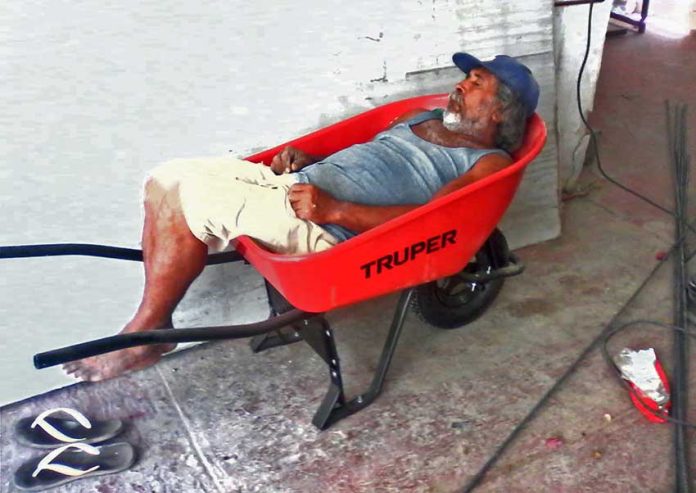As I sit at my desk attempting to bang out this week’s column, the noise of rotohammers combined with the off-key songs of several laborers fill our crumbling house with a discordance only experienced during a Mexican construction project.
After waiting an anxiety-fueled 22 months for our house deal to close, we finally began our renovation project 10 days ago.
We started with the demolition of several interior walls and the removal of most of the plaster on an exterior wall. Our work crew consisted of three laborers with two rotohammers, one 12-pound sledge hammer, two small hand sledges, a few chisels, two square-bladed shovels and 100 used, woven polyethylene feed bags for the rubble.
The Captured Tourist Woman had never experienced the complete and utter destruction wrought by hard-working Mexicans with power tools and sledge hammers; she was very impressed.
The first staging of scaffold, on an outside wall, was erected before all else. All three assured me they were capable of erecting multiple frames of scaffolding to create a safe working platform. I pointed them to a stack of frames, braces and planks and showed them where to start.
Since the ground below the scaffold setup was level and solid, I felt the assembly would be a simple test of their skills or lack thereof. As I left them to their devices, I envisioned Larry, Moe and Curly faced with a similar task. I was not disappointed by my canny premonition when I reappeared 10 minutes later.
I then worked with the three of them for 20 minutes and we successfully erected the scaffold across the back wall of the house. Sometime after lunch, when they had stripped off the bad plaster at the west end, we needed to move the western-most section of scaffold to the eastern end to access the wall at that end.
However, that scaffold section needed to have the legs extended because the ground dropped off four feet to the sidewalk. I pointed to a couple of six-foot wooden posts and explained the process of attaching leg extensions.
All three were smiling and nodding while assuring me with a repeated chant of “No hay problema.” Again, I left them to accomplish this seemingly simple task on their own.
When I returned a bit later, they had laid the 4×4 posts on two stacks of bricks which resembled something illustrated by Dr. Seuss; all higgledy-piggledy and wiggledy-figgledy. I stopped them before they attempted to stand a scaffold frame on their shaky construction.
I placed one of the posts alongside and parallel with a scaffold leg and explained how the post would be lashed on with multiple wraps of high quality Mexican bailing wire. They all grasped the concept quickly, or at least the part about the use of the wire seemed familiar.
As I watched, they all jabbered their rapid-fire Spanish, heavily laced with local slang, and formulated a plan. Two of the workers each grabbed a side of a scaffold frame and held it up vertically and elevated it to the approximate position it would assume once the posts were added. The third worker then picked up a post and held it against one leg of the scaffold with his shoulder, and then attempted to wrap up the assembly with the wire.
In retrospect, I should have stopped them when the two had picked up the scaffold frame, but my morbid curiosity held me back. By the time I put up my hand, and said alto, the two workers clutching the frame were having a very hard time keeping it in the air.
We found a nice level piece of ground and laid the frame down. I then directed them to lay a post next to each leg, take a rough measurement of the amount of extension required to level out the assembly over the uneven ground. With two workers holding the post tight to the frame, the third wrapped the wire and tightened it with the standard Mexican tie wire hook used for rebar. They found this simple feat of true Mexican engineering quite impressive.
The 45 minutes I had spent observing their antics gave me an accurate gauge of their construction experience, which was minimal at best.
The only thing I ask of any worker is to show up on time and work to the best of their ability. I found that questioning a worker will not reveal their true capabilities or skill level. After all, every albañil (mason) claims to be a tilesetter and every electrician claims to have in-depth knowledge of electrical systems.
And of course, with laborers being at the bottom of the construction hierarchy, their self-proclaimed expertise can be anywhere from digging holes to brain surgery.
To some, my method of testing the three laborers may be perceived as being cruel and unusual, but it quickly cuts to the chase of who can do what.
The next installment of this series will examine several pressing questions. Can old albañiles be taught new tricks? Will the use of modern tools and methods be instantly embraced, or fiercely rejected?
The writer describes himself as a very middle-aged man who lives full-time in Mazatlán with a captured tourist woman and the ghost of a half wild dog. He can be reached at [email protected].
